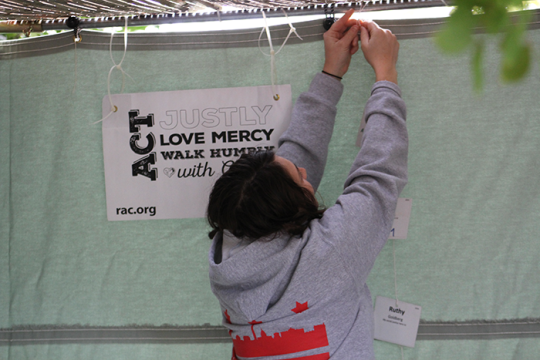
Tishah B'Av means "ninth of Av" and refers to a traditional Jewish day of fasting and mourning. Av corresponds to July or August of the secular year. For some, Tishah B'Av is the darkest of all days, a time set aside for mourning the destruction of both ancient Temples in Jerusalem.
The First Temple in Jerusalem was constructed during the reign of King Solomon (965-925 B.C.E.). The Bible tells us that no iron tools were used in the work, as iron was a material of weapons and war. The finished Temple was an awesome structure. Situated on a mountain 2,500 feet high, it had courtyards, a sanctuary, and a small room called the Holy of Holies, entered only once a year by the High Priest. It was in the Temple that the kohanim (High Priests) offered the ancient sacrifices on behalf of the people.
In 586 B.C.E., the Babylonian army surrounded Jerusalem. They broke into the city and conquered it. Then, on the ninth of Av, the Babylonian army destroyed the Temple. The Jews were sent into exile, crushed and despondent. According to some scholars, the prophet Jeremiah, grieving for the Temple, composed Psalm 137, in which he wrote: "By the waters of Babylon, we lay down and wept for thee Zion." A people who had grounded their entire religious system in a priestly Temple structure suddenly had it torn away from them.
Even as he mourned, Jeremiah still had hope. He told the people that they would one day return to Jerusalem and rebuild the Temple. He was correct. Some sixty years later, Persia conquered Babylonia, and the Persian king Cyrus allowed the Jews to return home. They rebuilt the Temple, but it was not nearly as magnificent as Solomon's Temple had been. Still, the Jews rejoiced, for once again they had an opportunity to be led by their priests and to offer sacrifices in their holiest site.
The Second Temple was enhanced and expanded during the first century B.C.E. by King Herod. He partially leveled the previous site, and then oversaw the construction of a Temple that rivaled that of Solomon in grandeur.
In 70 C.E., Roman legions, led by the General Titus, conquered Jerusalem and destroyed the Temple. It was the ninth of Av. Once again, the Jews were sent into exile, this time to Rome.
Some historians have expressed doubt that the actual destruction of both Temples occurred on the ninth of Av, but there is no disputing the fact that the day has become a symbol of Jewish tragedy. The synagogue ultimately replaced the Temple. The three daily worship services were substituted for the Temple's three daily sacrifices. The rabbi filled the leadership role once held by the kohein. But Jews never lost hope that the Temple would be restored. Their prayer books and their songs expressed their yearning, and Tishah B'Av became a vehicle for expressing their deep sorrow. Over the centuries, other great tragedies were linked to Tishah B'Av. Some of the Crusades' most brutal massacres were said to have occurred on this day. The expulsion edict from Spain was also supposedly issued on the ninth of Av in 1492. And, of course, many Jews remember victims of Nazi genocide on Tishah B'Av.
Tishah B'Av is marked by a twenty-four-hour fast, as well as by certain customs common to shiva, the period of mourning following a family death. Some Jews begin a period of semi-mourning three weeks before Tishah B'Av on the seventeenth of Tammuz. It was supposedly on this day in 586 B.C.E. that the Babylonians first breached Jerusalem's walls.
The mourning intensifies on the first of Av. No meat or wine is consumed and shaving is forbidden. On the evening before Tishah B'Av, a total fast begins. As on Yom Kippur, the fast extends until the following sundown. In the synagogue, the Book of Lamentations is chanted, as are kinot, dirges written during the Middle Ages. Sitting on low stools, a custom of shiva, congregants also read sections of the Books of Jeremiah and Job, as well as biblical and Talmudic passages dealing with the Temples' destruction. Jews do not study Torah except for those passages already mentioned. This is because Torah study is joyful and thus not permitted during Tishah B'Av.
To the early Reform Jews, mourning the destruction of the Temple in such elaborate fashion did not seem meaningful, especially since Reform Judaism did not idealize the rebuilding of the Temple. In recent times, Tishah B'Av observance has become a day to reflect on the moments of suffering in our heritage and those moments of suffering still occurring in our contemporary world. Today, many Reform Jews observe Tishah B'Av by attending services and reading from Lamentations, Jeremiah and Job. Some will refrain from certain pleasurable activities on this day.
The Western Wall, the imposing surrounding wall of Herod's Temple, is a holy site for Jews. The tiny scraps of paper placed between its ancient stones carry the prayers of Jews from all over the world. What stories the wall could tell – stories of Jewish tragedy and triumph. Perhaps it would say to us that we Jews have kept the Temple alive – wherever we have been – by creating a Judaism that has flourished and thrived.
Adapted from The Jewish Home, by Daniel B. Syme.
Rabbi Daniel B. Syme is Rabbi of Temple Beth El in Bloomfield Hills, Michigan and is a former Senior Vice President of the URJ.
Related Posts

Teens Make Their Voices Heard by Voting

